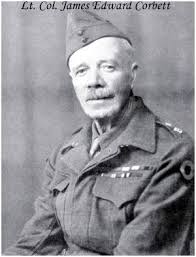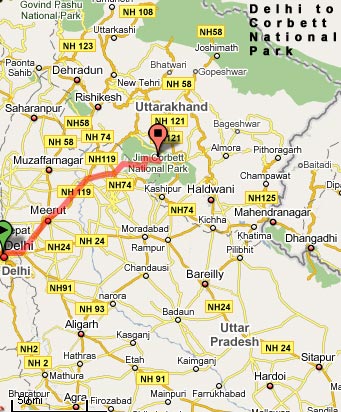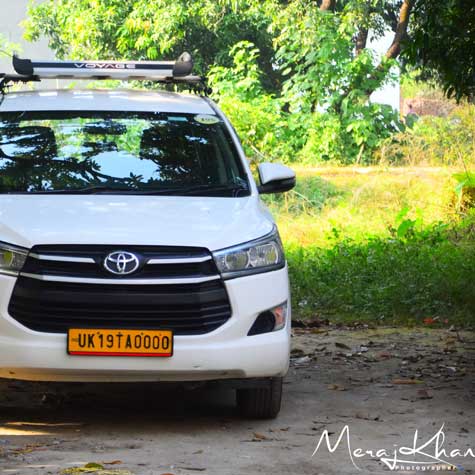About Jim Corbett National Park
Welcome to Jim Corbett National Park
THE LAND OF TRUMPET, ROAR AND SONG...
Jim Corbett National Park

Corbett National Park (CNP) is One of India's richest wilderness areas. The Tiger Reserve encompasses an area of 1288.34 sq km, which include two Protected Areas: Corbett National Park (520.82 sq. km) and Sonanadi Wildlife Sanctuary (301.18 sq. km).
Corbett National Park has captured the imagination of many with its diverse wildlife and breathtaking landscapes. The natural uniqueness of the area was recognised long ago and so in 1936 Corbett attained the distinction as the first national park to be established in mainland Asia.
Corbett National Park lies in two districts - Nainital and Pauri - in the hill state of Uttaranchal in northern India. It covers an area of 521 sq. km and together with the neighbouring Sonanadi Wildlife Sanctuary and Reserve Forest areas, forms the Corbett Tiger Reserve over 1288 sq. km.
Its geographical location between the Himalayas and the terai, and the streams, rivers and ridges crisscrossing the terrain, present Corbett with a remarkable variety of landscapes. This vivid mosaic of habitats - wet and dry, plain and mountainous, gentle and rugged, forests and grasslands - supports numerous plant and animal species, representing Himalayan as well as plains kinds. The most famous of Corbett's wild residents are the Bengal Tiger and the Asiatic Elephant, but with about 600 species of avifauna Corbett is one of the richest bird regions of India.
Important Links:
Corbett Safaris Online Bookings
Tour Packages
- Corbett Weekend Tour
- Corbett Safari Tour
- Bird Watching Tour
- Corbett Vacation Tour
- Dhikala One Day Tour
- Corbett Tow Days Tour
- Corbett Three Days Tour
- Corbett Four Days Tour
Corbett Night Stay / Hotels & Resorts
Corbett Forest Rest Houses / Forest Lodges

Jim Corbett National Park is one of the famous wildlife reserves in India, covering more than 520 sq km area in the Himalayan foothills. Every year thousand of tourists come to this park to enjoy the wild life adventure and nature. For the convenience of visitors Jim Corbett National Park has been distributed into five tourism zones. Every zone has its separate entry gate.
Forest Lodges in Dhikala Zone:
Dhikala Forest Lodge:
This is the long-familiar destinations in Corbett. It is placed at the edge of the Patli Dun valley. River Ramganga flows in numerous channels from there. Dhikala offers a superb uninterrupted panoramic sight of the valley, with the Kanda peak in the backdrop. This sight seems as much more imposing the tower in the vicinity Dhikala. The Tourist complex on Dhikala chaur ( one of the last large meadows of the Park) and Phulai chaur. A reader through the many paths through chaurs is rewarded by the observations for the wild elephants, chital, the stag of pigs and many species birds of the meadows and the raptors. Old convalescent home in Dhikala is a historical structure, having been built more than a hundred of years.
Sarapduli Forest Lodge:
This forest lodge is on Dhangarhi-Dhikala road. It is located downstream from Gairal on the dish of the southern bank Ramganga while the northern bank is drawn up vis-a-vis a strong peak. Movement of the large mammals (tigers, elephants included) is very high, in Sarapduli. It is also a good place to see the crocodiles and also a good thing for the observation of birds.
Sultan Forest Lodge:
Sultan is the first forest lodge during the driving way of Dhangarhi with Dhikala. Sultan is named after the Stupid Sultan, the seasonal flow which crosses this area. It is characteristic in the dense zone of forest.
Gairal Forest Lodge:
This forest lodge is reached by a short turning with broad of Dhangarhi-Dhikala forest main roads. It is located on banks of Ramganga close to the place where the first entry gate of the park. In Gairal Ramganga the portrait d' a character different from this fact at places downstream (like Dhikala). Here, it acts; a crystal clear, fast, which runs river of mountain which runs through the picturesque forests. To be out of the way, Gairal presents ideal conditions to look at fauna and the birds in all peace.
Khinnanauli Forest Lodge:
Khinnanauli is situated in the middle of Khinnanauli chaur, this forest lodge is an excellent tiger territory. It is one of most recently built convalescent homes Corbett. Its strategic site offers an easy escape to the various parts of the park.
Kanda Forest Lodge:
Kanda Forest Lodge is the highest forest lodge (nearly 1 km altitude) in the Jim Corbett National Park. Kanda is more in north of Corbett National Park. To be at the top, you have an advantage of experiment and find image all the valley with Ramganga point angle. Kanda located in the north of the park is also known as that the neighbour of The Himalayas for its resemblance to the Himalayas in terms of climate, vegetation and fauna. Here, you obtain the true feeling of the Himalayas.
Forest Lodges in Bijrani Zone:
Malani Forest Lodge:
This forest lodge is to 12 km in the North-West because of Bijrani. Located on the edge of the central zone of the Park, Malani has offer; one of most picturesque and loneliness. The reader of Malani is very enriching in the observations by mammals and the birds.
Bijrani Forest Lodge:
The zone located around Bijrani once a part; a block of catch the sight. During the British period, it was much more famous for the quality of the hunting which it offered to shikaris. Compared to Dhikala, the ground with Bijrani is drier and the vegetation is diversified.
Forest Lodges in Jhirna Zone:
Jhirna Forest Lodge:
This forest rest house is with an interior of the southern limit of the Park. The rest house is on the road of Ramnagar to Kalagarh that turns in a East-West direction through the Park. The landscape is drier than in Dhikala and of the vegetation is mainly undergrowth. Jhirna was an agricultural village until 1994, date on which it was moved within the framework of the Tiger project. The hills in the north of Jhirna are covered with dense spots of bamboo. In more d' to be a good habitat for the tiger, the leopard and the stag, the place accommodates the other mammals like interesting sloth bear and the wild boar. A variety of birds can also be appreciated here.
Forest Lodges in Sonanadi Wildlife Sanctuary:
Lohachaur Forest Lodge:
This lodging is located in the northern part of the reserve of tigers of Corbett RF buffer zone. It is located on banks of the Mandal river upstream of its confluence with Ramganga.You can get access from Durga Devi gate.
Rathuadhap Forest Lodge:
Rathuadhap is one of the famous place for the elephants in Jim Corbett National Park. It is located in the north of the buffer; Rathuadhap is on the forest road connecting Durga Devi in the east and towards Vatanvasa in west.
Halduparao Forest Lodge:
Halduparao rest house is one of the oldest rest houses. It was built hundred years ago. It is placed between the Palain and Sonanadi rivers just before they meet into Ramganga reservoir. Halduparao is the best destination to watch wild elephants during summer season.
Important Links:
Corbett Safaris Online Bookings
Tour Packages
- Corbett Weekend Tour
- Corbett Safari Tour
- Bird Watching Tour
- Corbett Vacation Tour
- Dhikala One Day Tour
- Corbett Tow Days Tour
- Corbett Three Days Tour
- Corbett Four Days Tour
Corbett Night Stay / Hotels & Resorts
Sir Jim Corbett
Edward James "Jim" Corbett (25 July 1875 in Nainital, India - 19 April 1955 in Nyeri, Kenya) was a legendary British hunter and tracker-turned-conservationist, author and naturalist, famous for hunting a large number of man-eating tigers and leopards in India.
Corbett held the rank of colonel in the British Indian Army and was frequently called upon by the government of the United Provinces, now the Indian states of Uttar Pradesh and Uttarakhand, to kill man-eating tigers and leopards that were preying on people in the nearby villages of the Garhwal and Kumaon regions. His hunting successes earned him longstanding respect and fame in Kumaon. Some even claim the locals considered him a sadhu (holy man).
Corbett was an avid photographer and after his retirement authored Man-Eaters of Kumaon, Jungle Lore, and other books recounting his hunts and experiences, which enjoyed critical acclaim and commercial success. Later on in life, Corbett spoke out for the need to protect India's wildlife from extermination and played a key role in creating a national reserve for the endangered Bengal tiger by using his influence to persuade the provincial government to establish it. In 1957 the national park was renamed Jim Corbett National Park in his honour.
The legend of Jim Corbett is still alive, not only in the minds and hearts of the people of Kumaon & Garhwal, but also all over the world. His six books, which are the nearest to his autobiographies, have never been out of print. There are four biographies on him and three films on his life have already been made.
Edward James Corbett was born on 25thJuly 1875 of nglish ancestory in Nainital. He lived in Gurney House in Nainital for the greater part of his life with the last of his large family, his mother Mary Jane Corbett and his sister Margaret Winfred Corbett, fondly called Maggie.
His father, the postmaster in Nainital, died when Jim Corbett was four. It fell to Corbett's mother to raise and educate 12 children on a widow's meager pension. His mother, Corbett recalled, "had the courage of Joan of Arc and Nurse Clavell combined". After the death of his mother in 1924, Maggie and Jim were constant companions to each other and both chose not to marry.
Jim Corbett was a simple, unassuming man of six feet and a few inches with blue eyes. He dressed only in bush clothing and wore an assortment of hats which he would never forget in the jungle. He was shy but liked the company of his Indian friends. He was known as a shikari, a killer of man-eaters. He loved the people of India and understood their needs and sentiments. It is for them that he risked his life many times to shoot the ten man eaters about whom he has written in 'The Man Eaters of Kumaon, Man Eating Leopards of 'Rudraprayag' and 'The Temple Tiger'. He never shot a tiger or leopard until he was convinced that the animal had taken to man eating.
Much of his time was spent boating and angling on the lake in Nainital. Kaladhungi was his winter home. In the forests of Kaladhungi he learnt his first lesson in hunting from his eldest brother Tom. He hunted his first leopard at the age of six. Jim was blessed with an excellent eyesight, keen hearing, remarkable memory and the power of deduction and observation supplemented with toughness and courage. He could sing and play the guitar. For his living, he worked for 22 years (1892-1914) with the Bihar North Western Railways. He also operated a house-agenting business in Nainital.
His book My India is a story of his life in Bihar and his association with India. He fought in the First and the Second World Wars. He also trained troops for the army in jungle warfare and was appointed Lieutenant Colonel. He was accorded several honors and medals.

Important Links:
Corbett Safaris Online Bookings
Tour Packages
- Corbett Weekend Tour
- Corbett Safari Tour
- Bird Watching Tour
- Corbett Vacation Tour
- Dhikala One Day Tour
- Corbett Tow Days Tour
- Corbett Three Days Tour
- Corbett Four Days Tour
Corbett Night Stay / Hotels & Resorts
Corbett Maps
Location Maps of Jim Corbett National Park:
Google Map of Jim Corbett National Park:
View Larger Map
Important Links:
Corbett Safaris Online Bookings
Tour Packages
- Corbett Weekend Tour
- Corbett Safari Tour
- Bird Watching Tour
- Corbett Vacation Tour
- Dhikala One Day Tour
- Corbett Tow Days Tour
- Corbett Three Days Tour
- Corbett Four Days Tour
Corbett Night Stay / Hotels & Resorts
How to Reach Corbett
By Air
Jim Corbett National Park doesn't have an airport. If one wants to go by air, Phoolbagh in Pantnagar is the nearest airport. It is located 78 km away from Jim Corbett. Pantnagar airport is well connected with major cities in India, so one can easily reach there. Delhi which is 300 km away is the nearest international airport for the people travelling from abroad. Flights from Lucknow and New Delhi travel to Pantnagar twice a week, so one can arrange accordingly. One can easily find taxi from Pantnagar to Jim Corbett National Park.
By Rail / Train
Ramnagar railhead is the nearest railway station to Jim Corbett Wildlife Sanctuary. This railway station is connected to major cities of India, the nearest being New Delhi railway station. Ranikhet Express is one of the trains that operate from New Delhi railway station to Kathgodam railway station. This train runs daily between the two places. Bus or taxi are easily available that will take you to Jim Corbett National Park. Also, trains are available from Moradabad railway station.
Delhi To Jim Corbett By Rail / Train:
Ranikhet Express - The train leaves Delhi at 2200 hrs and reaches Kathgodam in the morning. As the train reaches the station quite early it is advisable you ask the hotel for pick up facility. Alternatively, Ranikhet Express starts from Delhi to Kathgodam, comes back to Moradabad and via Kashipur reaches Ramnagar next day morning, i.e 2 days required. To save time getting down at Kathgodam is feasible and from there take a cab to National Park.
Corbett Link Express - Leaves Old Delhi at 2245 hrs and reaches Ramnagar at 0530 hrs
Kathgodam Express - leaves Old Delhi at 2245 hrs and reaches Kathgodam at 0715 hrs
By Road
Jim Corbett National Park is well connected to major cities of India. This national park is around 25 kms from Ramnagar, from Lucknow, the National Park is 433 kms via Bareilly and from New Delhi its 300 kms away.
Delhi To Jim Corbett National Park By Road:
Route: Delhi - Hapur - Gajraula - Moradabad - Kashipur - Ramnagar - Corbett National Park
Distance:
- New Delhi 260
- Nainital 65
- Ranikhet 93
- Agra 340
- Dehradun 250
- Haridwar 180
- Rishikesh 210

Important Links:
Corbett Safaris Online Bookings
Tour Packages
- Corbett Weekend Tour
- Corbett Safari Tour
- Bird Watching Tour
- Corbett Vacation Tour
- Dhikala One Day Tour
- Corbett Tow Days Tour
- Corbett Three Days Tour
- Corbett Four Days Tour
Corbett Night Stay / Hotels & Resorts
Best Time to Visit
Jim Corbett National Park has been a haunt for tourists and wildlife lovers for a long time. Tourism is allowed in selected areas of Corbett Tiger Reserve so that people get an opportunity to see its splendid landscape and the diverse wildlife living here.
In recent years the number of people coming here has increased dramatically. Presently, every season more than 70,000 visitors come to the park from India and abroad.
General Information
- Altitude: 385-1100 meters above mean sea level.
- Annual rainfall: 1400-2800 mm.
- Temperature range: 4 degree in winter to 42 degree during summer.
Corbett National Park remains open throughout the year for the visitors from Jhrina zone. Every year Bijarani zone get operational from Mid of October and The core area of the national park Dhikala zone get operational from 15th of Nov. The main reason for closure of the Bijarani and Dhikala zone during the rest of the year is that during the monsoons most of the roads get washed away. Repair work starts after the rains end and it is only by October to November that roads to Bijarani and Dhikala are back in motorable condition.
Seasons: There are three well defined seasons
Winter: November to February
Summer: March to June
Monsoon: July to October
However, Corbett National Park remains open throughout the year for the visitors from Jhrina zone but the best time to visit Corbett is from 15th November to 15th June because during this period of time all the tourism zones of Corbett are open for visitors and one can visit the entire national park area.
To know more about Corbett National Park , write email on merajklg@gmail.com
Important Links:
Corbett Safaris Online Bookings
Tour Packages
- Corbett Weekend Tour
- Corbett Safari Tour
- Bird Watching Tour
- Corbett Vacation Tour
- Dhikala One Day Tour
- Corbett Tow Days Tour
- Corbett Three Days Tour
- Corbett Four Days Tour








